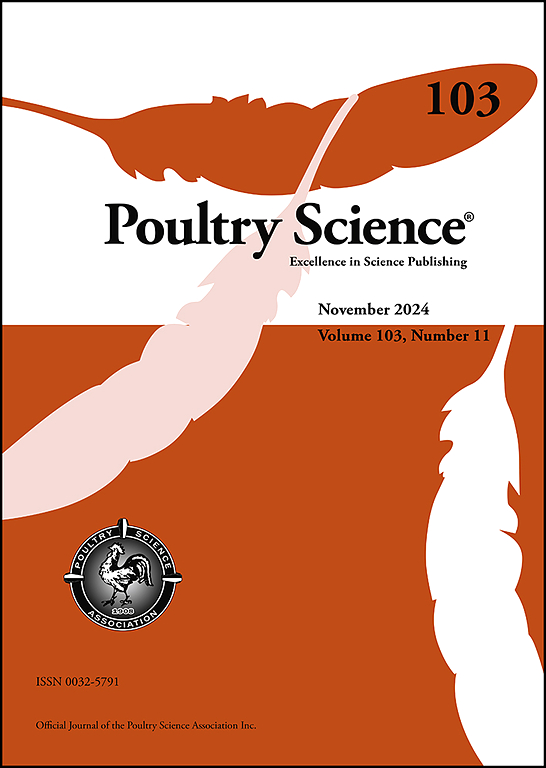道州灰鹅胚胎期腿肌发育过程中MicroRNA的表达与分析
IF 4.2
1区 农林科学
Q1 AGRICULTURE, DAIRY & ANIMAL SCIENCE
引用次数: 0
摘要
胚胎阶段骨骼肌的发育对家禽肌肉生长至关重要,其中microRNAs (miRNAs)起着至关重要的作用。鹅是主要的家禽物种之一,但mirna如何调节胚胎阶段鹅的骨骼肌发育仍然知之甚少。本研究研究了道州灰鹅(中国一种珍贵品种)E14、E21和E28三个阶段胚胎腿肌肉发育的组织学特征和miRNA表达谱。目的是鉴定稻州灰鹅肌肉发育相关的差异表达mirna (DEMs),并利用生物信息学预测这些DEMs的潜在生物学功能。组织学观察显示肌肉发育的阶段特异性,在E14时成肌细胞增殖,在E21时分化,在E28时肌纤维成熟。通过miRNA测序共鉴定出340个已知miRNA和270个新的miRNA,其中miR-148a-3p、miR-1a-3p、miR-100-5p、miR-206和miR-92-3p是最丰富的。此外,差异表达分析在E14与E21、E14与E28以及E21与E28的比较中分别鉴定出105、107和70个dem。随机选择的12个dem(9个已知mirna和3个新mirna)的表达模式通过定量实时聚合酶链反应(qRT-PCR)验证,证实了测序结果。预测miRNA靶基因的功能富集分析显示,MAPK、TGF-β和Notch信号通路参与胚胎肌发生。对排名前10位的dem及其靶基因进行miRNA-mRNA互作网络分析,揭示了let-7k-5p-MAP3K1、miR-133a-3p-FZD7、miR-133c-3p-STAT3、miR-187-3p-ZEB2和miR-205b-SETD3等关键调控节点,并通过qRT-PCR验证了其反向表达模式。我们推测上述途径以及这些miRNA-mRNA靶点关系在调节道州灰鹅胚胎肌肉生长发育中发挥重要作用。这些发现首次提供了鹅体内胚胎腿肌的完整mirna图谱,为进一步研究鹅肌肉发育的分子调控机制提供了基础参考和理论框架。本文章由计算机程序翻译,如有差异,请以英文原文为准。
Characterization and analysis of MicroRNA during leg muscle development in embryonic stage of daozhou grey goose
Skeletal muscle development at the embryonic stage is critical for muscle growth in poultry, during which microRNAs (miRNAs) play a vital role. Geese are one of the main poultry species, but how miRNAs regulate skeletal muscle development in geese during the embryonic stage remains poorly understood. This study characterized histological features and miRNA expression profiles during leg muscle development in Daozhou Grey goose (a prized Chinese breed) embryos at three stages (E14, E21, and E28). The objective was to identify differentially expressed miRNAs (DEMs) associated with muscle development in Daozhou Grey goose and utilize bioinformatics to predict the potential biological functions of these DEMs. Histological observations revealed stage-specific muscle development, marked by myoblast proliferation at E14, differentiation at E21 and muscle fiber maturation at E28. A total of 340 known and 270 novel miRNAs were identified by miRNA sequencing, with miR-148a-3p, miR-1a-3p, miR-100-5p, miR-206, and miR-92-3p being the most abundant. Furthermore, differential expression analysis identified 105, 107 and 70 DEMs across E14 vs E21, E14 vs E28, and E21 vs E28 comparisons, respectively. The expression patterns of the twelve randomly selected DEMs (9 known and 3 novel miRNAs) were validated by Quantitative real-time polymerase chain reaction (qRT-PCR), confirming the sequencing results. Functional enrichment analysis of predicted miRNA target genes revealed involvement of the MAPK, TGF-β and Notch signaling pathways in embryonic myogenesis. The miRNA-mRNA interaction network analysis of the top 10 most DEMs and their target genes revealed key regulatory nodes such as let-7k-5p-MAP3K1, miR-133a-3p-FZD7, miR-133c-3p-STAT3, miR-187-3p-ZEB2, and miR-205b-SETD3, with inverse expression patterns validated by qRT-PCR. It was hypothesized that the above pathways as well as these miRNA-mRNA target relationships play an important role in the regulating embryonic muscle growth and development of the Daozhou Grey goose. These findings provide the first comprehensive miRNAs profile of embryonic leg muscle in vivo in geese, offering a basic reference and theoretical framework for further research on molecular regulatory mechanisms of goose muscle development.
求助全文
通过发布文献求助,成功后即可免费获取论文全文。
去求助
来源期刊

Poultry Science
农林科学-奶制品与动物科学
CiteScore
7.60
自引率
15.90%
发文量
0
审稿时长
94 days
期刊介绍:
First self-published in 1921, Poultry Science is an internationally renowned monthly journal, known as the authoritative source for a broad range of poultry information and high-caliber research. The journal plays a pivotal role in the dissemination of preeminent poultry-related knowledge across all disciplines. As of January 2020, Poultry Science will become an Open Access journal with no subscription charges, meaning authors who publish here can make their research immediately, permanently, and freely accessible worldwide while retaining copyright to their work. Papers submitted for publication after October 1, 2019 will be published as Open Access papers.
An international journal, Poultry Science publishes original papers, research notes, symposium papers, and reviews of basic science as applied to poultry. This authoritative source of poultry information is consistently ranked by ISI Impact Factor as one of the top 10 agriculture, dairy and animal science journals to deliver high-caliber research. Currently it is the highest-ranked (by Impact Factor and Eigenfactor) journal dedicated to publishing poultry research. Subject areas include breeding, genetics, education, production, management, environment, health, behavior, welfare, immunology, molecular biology, metabolism, nutrition, physiology, reproduction, processing, and products.
 求助内容:
求助内容: 应助结果提醒方式:
应助结果提醒方式:


